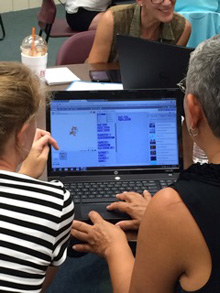 Computer coding is a trending topic these days. One reason why is a key feature of the current focus in STEM (science, technology, engineering, and mathematics) education—President Barack Obama’s Computer Science for All initiative. According to folks in the White House, coding has become a new “necessary skill” for our students’ economic opportunity and social mobility.
Computer coding is a trending topic these days. One reason why is a key feature of the current focus in STEM (science, technology, engineering, and mathematics) education—President Barack Obama’s Computer Science for All initiative. According to folks in the White House, coding has become a new “necessary skill” for our students’ economic opportunity and social mobility.
Computational thinking, math, design, engineering, and data analysis are considered essential skills to prepare students for the high-paying technology jobs that are open and currently unfilled. That is all well and good, but literacy-focused educators may be wondering how literacy fits it in with coding movement.
As a school librarian invested in literacy education, I have seen school and public librarians embrace the computer coding movement. Some people argue that libraries have no place in computer science and should stay with their traditional programs and services. In contrast, proponents see that computer coding helps develop critical thinking and problem-solving skills, and these are at the core of our professional mission: to help people understand how to solve problems using information effectively, which are skills that support people as lifelong learners.
Not until a group of librarians and I visited the South End Technology Center (SETC) in Boston, MA, last June that I realized computer coding has a big place in literacy education. Dr. Susan Klimczak, L2T Director of Special Programs at SETC, spoke to us about how computer coding is essentially writing a story. The five-stage story structure is all there. When you code, you set the scene, build tension, create climax, include falling action, and come to a resolution—think Minecraft game design. The possibilities for librarians to collaborate with English and reading teachers using code are wide open and exciting.
At a sold-out Coding With Scratch workshop for school librarians in August, facilitator and school librarian Jennifer Robinson and I were impressed by librarians’ eagerness to learn and bring coding into their schools. After Jen explained the basics about Scratch, we let the librarians loose, tasked with developing a short computer program with a sprite (character), setting, costumes, and actions. They quickly learned the start, loop, repeat, and sequence commands. Excitement grew as the participants interacted and learned through trial and error. These educators experienced the design process emotions of frustration, pride, dismay, and exhilaration and were hooked on the value of bringing coding into the literacy fold.
To show librarians what a collaborative English language arts and coding project could look like, Jen described her project with fifth-grade students. Working as an instructional partner with the classroom teacher, Jen had the students create a computer program using Scratch to show evidence of competency in a Common Core narrative writing standard. First, students read a biography and then created a narrative script highlighting important parts in this person’s life. After a brief tutorial on Scratch, students attempted to master the broadcast and receive commands to code a dialogue sequence from their script.
Librarians who are on the coding bandwagon have the dispositions to be comfortable with the discomfort of taking risks and letting go of control. They are trained collaborators who support traditional literacies of reading and writing but are also technology leaders willing to try new things and create student-centered learning activities. Check with your school librarian for ways to bring coding into your literacy instruction.
 Mary Moen is a visiting research professor and the coordinator of the School Library Media Program at the University of Rhode Island’s Graduate School of Library and Information Studies. A former school librarian, her research interests include teacher professional learning of technology, digital literacy, and makerspaces in libraries.
Mary Moen is a visiting research professor and the coordinator of the School Library Media Program at the University of Rhode Island’s Graduate School of Library and Information Studies. A former school librarian, her research interests include teacher professional learning of technology, digital literacy, and makerspaces in libraries.
This article is part of a series from the Technology in Literacy Education Special Interest Group (TILE-SIG).